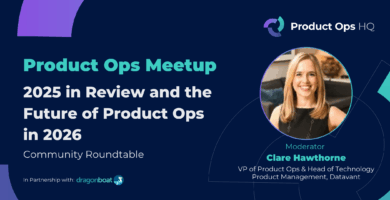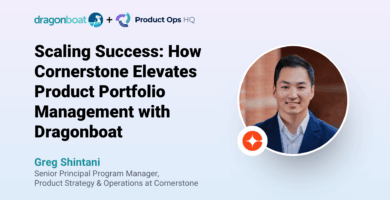Events • On Demand | Watch Time: 20 minutes
From Product Management to Strategic Leadership: How to Take Your Product Practices to the Next Level
Productized Conference 2024
During the Productized Conference 2024 in Lisbon, Becky Flint shared her unique journey in product leadership and operating excellence. Reflecting on her experience at companies like PayPal and Feedzai, she emphasized the importance of community, strategic leadership, and collaboration in enhancing product practices. Becky provided insights on how product managers can evolve their roles to become strategic product leaders by understanding and leveraging their product and portfolio strategies while fostering collaboration across teams.
Whether you’re a product manager, product operations, product leader or a startup founder, this session offers valuable strategies on how to thrive in high-growth environments, align product vision with business outcomes, and deliver real customer value.
Key Takeaways
- Strategic Leadership is not just for C-level executives: Product managers play a crucial role in forming and executing strategies within their teams.
- Balancing Insights and Revenue: Understanding user insights is fundamental, but product managers should also focus on revenue insights to drive better decision-making and prioritize initiatives effectively for business impact.
- Efficiency in Resource Allocation: Maximizing market opportunities requires effective management of resources, especially when budgets are limited.
- Collaborative Roadmapping: Involving cross-functional teams and stakeholders in the planning process leads to more informed and effective product roadmaps.
- Product Operating Excellence: Emphasizing both product and portfolio excellence alongside operational excellence can significantly enhance a product manager’s impact and the overall success of product initiatives.
Transcript
The following transcript has been altered for readability.
Tracy Rolling: Welcome to the stage, Becky Flint!
Becky Flint: Thank you, Tracy. Good morning. It is so great to be here, to be in Portugal again. It’s interesting, some of you may not know but Portugal is a special place in my product leadership journey. 16 years ago, I launched PayPal Portugal, as a Lead of Product Operations. Has anyone heard of PayPal?
Great! And 8 years ago, I was actually working very close to here, across the street, a couple of blocks away, and the building actually overlooks this stadium, in a small startup company, fast-growing, called Feedzai. Has anyone heard of Feedzai? It is a great company because it went from a small startup, cramped in a room, to a mighty unicorn using AI to fight financial fraud. I built the first product teams with a small group. And it’s really amazing to see how the company grow.
And today, Dragonboat, our company, also has a strong team all over in Portugal. So it’s great to be here. Thank you. And why is it important for this conversation here? It’s talking about how community and the growth coming together.
Now, I’m going to go, not going through too much details in my personal journey, but what I’m trying to highlight is not just my journey. Throughout my career, I worked with thousands, thousands of product managers and many more in the product management function or related areas. And for these functions and these roles, what I found out, first was a passenger, I’m just someone in a boat. The boat is going somewhere, and I’m trying to figure out, struggling. And later on, I was a co-pilot and trying to figure out where to go. And somewhere down the road, I became the driver of the product operating model.
Product Teams – Success and Struggles
Becky Flint: As we’re going through the journey, I found out something very interesting. There are great product managers who succeed in the same company whereas other great product managers just really, really struggle. And the same product managers go from one company to another, same industry, even the same product. They went from very successful to not. Some teams had very few resources compared among things they have to do, and somehow, magically, they just made it happen. And there are some teams who had a lot of resources. And I’m not sure what happened. Just they struggle. And there are also companies where competitive threats come through, they just crack. And some companies really, like this team, with the threat in the environment, really thrive. So what is the difference? What is the difference?
And in this conference, I talked to quite a few people. I’m an introvert, not very good at talking to a lot of people. But the community makes me feel comfortable. So I heard hope, but I also heard a lot of stress, a lot of hopelessness. And so I feel like strategic leadership is not for me. I get handed over something, I have to do it. I don’t have a hope to get out of here. So where do we go from here? Sure, it’s easy for you to say. You’re the CEO. You can decide on everything. I wasn’t a CEO before for over 20 years. And still, I don’t get to decide on everything in case you know you’re a CEO. You don’t get to decide on anything, pretty much.
What is Strategic Leadership?
Becky Flint: So what is a strategic leadership? And why we want to do it? Is it really just for C-level folks? So the earlier talk actually makes a lot of similar concepts of visions. And I was actually talking to Radhika earlier how many of the concepts are really similar if you take one level higher to think about it. Sure, you have to have a vision, and that has to be done at the executive level. From vision, you have to decide on your strategy. Now, is a strategy only at one level? Is a strategy only at executive level? Or actually, strategy can be done both in terms of improving code quality. How do we achieve the improving code quality? That is a strategic approach.
So forming strategy is one part. Deploying the strategy is the second, and then lastly is monitoring. Strategy is a hypothesis, right? Do we drive the result we’re trying to accomplish? And do we get to at the speed that we need to? Are there better options? So as product managers, as product operations, product executives, we all play a role. We do have that part of a strategic power. And practice strategic leadership, it actually can happen and should happen all the time. And these are the elements of that. Ok, I’m done, leaving. Not yet.
So you say, OK. How does it relate to me today? How do I take what I have today? There’s not enough talk about that. So I want to first start with the basics, right? As product managers, we are taught and it’s critically important the foundations. We need to gain user insights. We have to have deep user insights. You don’t have to say, hear that from me anymore. You’ve probably heard plenty of that. Deep user insights help us to build strategies so that we can create product roadmaps, rally the company along, building product customer love. These are essential. So never go away. And we continue to practice it. I’m not doubling any of the importance. This is the foundation, right? This is the foundation. Otherwise, we’ll have cracks on them.
As a strategic leader, we also have to balance. There are additional things that come to them, we all operate within the constraints. So I think about the strategy a lot of times within the constraint we have. These are the additional things expected of us: we need to drive more revenue. There’s nothing wrong. It’s critical for product managers to talk about it, think about it. We have to drive revenue. Is it us only? No. But revenue is oxygen, and the revenue gives us the opportunity to experiment more, to explore strategy. We can’t take it one shot.
Faster time to market is not deliver fast. Time to market to value is something different. We have to think about it. If something is really big, how do we still deliver a piece of it so we don’t lose the market? Grabbing market share is ever so important. It gives you the optionality, the opportunity to survive for another day.
So the next one, is higher investment efficiency. We don’t talk as much, but this is really, really important. So we’re going to dive that a little bit more in our conversation. Efficiency means you can do more with limited resources, and we all have limited resources. What are the tricks? I’m going to cover a little bit.
And last but not least, we know empowered teams. We have our team. Are they really our team? Are they our only team? Think about it. Product managers quite often working with your scrum teams, right? That’s your team. What about the others? If you want to accomplish all of that, you have a bigger and broader team. We have to work differently.
So how do we bring this along with what we already have? That we know as a product manager, as a PM, we know certain things we already know. We need to gain deep user insights. Now we need to add something more to it. We need to gain both the user and the revenue insights. Gosh, do we have more hours in a day? No. And remember one thing is very important. Our team is not just us. Who takes ownership on that?
If you’re in B2B, let’s use an example. There are 20 sales requests. All say, you know, we’re going to close the deal. Either we’re going to lose it. You’re going to be revenue aware, right? What do we do? Do we try to figure out which of the 20 ideas and stuff? No, because revenue leaders owns that. So instead of the PM stuck in the middle, be the messenger and struggle, spend a lot of your time dealing with that, have the sales leader say: “Hey, after all these things, all these requests associated to deals and so forth, what are the most likely one? What’s the most important one? How do you prioritize that, right?”
So when you try to put the ownership of the right people first, they give you the inputs, not the only inputs, one of the critical inputs to your roadmap. And it would say out of those 20, two of them are really critical this quarter. And the other ones we could wait, and the other ones like, you know, yes, right? So when we have that input, that is not from us, we have this collaborative relationship with our stakeholders, or in my world, we’ll call it our team, our extended team, cross-functional team.
So one example from a CPO, from our CPO series, Lydia, she was talking about when she goes to planning, she had her Head of Customer Success and the Head of Sales in the same room. She will plan her roadmap at 120% of capacity. And she says: “Look, we all wanna do this, but this is the reality. What is the best way to sequence that?” And in that time, you actually get the revenue leaders who own their numbers to provide the input. So walk out of the room, nobody’s happy. If there’s someone super happy, that’s probably not a good decision. Someone all have to make some compromises so that we know this is the right thing to do across the board.
Product Portfolio Strategy
Becky Flint: And that kind of tied to something about not just product management, talking about a product portfolio strategy. What does it mean? As a company, as an overall business, what to say, does it make sense to spread peanut butter, our investment strategy across the board? Or maybe in this area needs more engineering investment because there’s more potential to grow. Maybe it’s a V1 to VN. This area, maybe optimization would have minimum investment and have more marketing and sales support. Maybe we should invest on the new areas. So the idea is that we build not just a product strategy.
You say, well, we have a small team, we just have one product. Think again. Every single digital product pretty much is a portfolio. If you’re a marketplace, you have a buyer and sellers. Guess what? Two products, right? That example, coffee shop, you have a different users. They’re actually multiple product in the portfolio. You have to say, do I invest in, for example, that example is, do I invest again in brand? Do I invest the user to buy a coffee? Where needs more help? And that varies. So your product portfolio strategy coming together actually give you a lot more power in the impact you want to create. And that’s a strategic thought process along it.
Product Portfolio Roadmaps
Becky Flint: And that obviously lead to product portfolio roadmap. Sometimes there’s nothing on your engineering roadmap for one product. There are other things to be built. Sometimes you have too many things. Some of you coming from bigger companies say: “Hey, we just realized this team does something very similar from mine. And we are sometimes, we’re contradicting from each other.” When I was at PayPal, we put someone, we consolidate the product organization into a global product organization versus very siloed different teams. We found out there were 60, six-zero onboarding flows. Can you imagine what the customer experience would be? Let alone the wasted resources. When you think about silo and not think about your entire product portfolio, you have all sorts of challenges coming here.
In addition to how we think about the product and portfolio overall, and to working together with team, building on top of what we already have, we already have to add additional things. Thinking about how we work through constraints. We have to think about what’s a resource allocation. As a previous example showed, if you don’t have engineering resources, most of the PM team has to struggle with that. What other resources you can have? Through working through a resource allocation, make your prioritization much easier. We never have only one goal. We have multiple strategies and hypotheses. So where are we gonna spread between them so we actually can be successful? Each one will have an opportunity to be successful.
Delivery Orchestration
Becky Flint: The second part we think about is delivery orchestration. We don’t think enough sometimes for PMs to say, someone else is taking care of it. But we own the product. When we tell the market, when we tell our business partners, we’re gonna have this, and we don’t really know where things are, that’s not very good. If something gets delayed, some other teams get delayed, how we know that is going to impact other business and other strategies, that’s also another challenge. Therefore, we have to think about how we can orchestrate across different product teams, and different engineering teams, and different functions, and different go-to-market teams.
Product Development Lifecycle
Becky Flint: So last but not least, is your product development lifecycle needs to go including go-to-market. So we think about a product development lifecycle, typically it could be something more like delivery, discovery, delivery. There’s impact, we have to add that to it otherwise, your product on the shelf, it just isn’t good enough building it.
So adding these operating excellence, and that’s really the rise for product operations, because these take a lot of work. Having your partner to help drive this together, really make the PMs a lot more strategic, be able to think about stuff, and be able to actually say where we are going to adjust, change, up-level, or reduce investment.
Product Operating Excellence
Becky Flint: So put it all together: the product operating excellence, include both on one side, as you can see, around the product and the portfolio excellence. This is something product managers are very familiar with. And your right-hand person, and the left-hand person need to work together. The other party is the operating excellence. That would include the resourcing, would include a go-to-market and PDLC, would include orchestration of a delivery. So if you have a small team, “I don’t have product operations”, it doesn’t mean you don’t do product operations. When there’s a product, there’s operations, because every element is coming together.
And if you say, “Well, I’m just a PM, do I need all that skills?” You need both skills. It’s a different amount of use. When you’re individual PMs, maybe you focus a lot more on your product excellence, but you still have to work with others. As you grow in your career, have a bigger sphere of influence, there’s a little switch on when you need it. So there’s never a time that you don’t need to and not ready to use it.
I’m going to use an example here. We talk about strategy formation. A lot of times people understand that. What does it mean about deploying and monitoring? In this example, there are two strategies to grow your business. And you can see, maybe this is defined at the executive level. We can see one strategy is not doing so well, right? We don’t forget about it. This is failing. The monitoring is not doing well on the strategy. One is doing well. So you have a choice to make. At executive level, you think, do I double down on the areas that are working well? Or do I shift resource coming over that affect executive?
And that thought process should also go to product. Should I deliver product roadmap? Should I switch my product strategies to support the others? And those collaborations in your entire product operating model would help you to be successful in your strategic product leadership.
Communities and Resources
Becky Flint: And last but not least, you’re not doing this alone. Here are the communities you can join: Product Ops, CPOs and product executives. And if you are curious where you are on your company or your team or your own product operating excellence journey, check out this questionnaire.
Thank you!
Reference
- Productized Conference: https://www.productized.co/
- PayPal: https://www.paypal.com/
- Feedzai: https://feedzai.com/
- Radhika Dutt: https://www.radicalproduct.com/
- Lydia Varmazis: https://www.lydiaco.co/
- The CPO Series Webinar with Lydia Varmazis: Aligning Around the Right Success Metrics
- Product Ops HQ: http://productopshq.com
- The CPO Series: https://dragonboat.io/webinars-tags/the-cpo-series/
- Assess Your Level of Product Operating Excellence: https://dragonboat.io/lp/poe-assessment/
Featured Speaker

Becky Flint
Founder and CEO of Dragonboat
Becky is a product and tech executive based in the Silicon Valley. She has built and scaled product and engineering teams globally for both startups and Fortune 500 companies. Currently Becky is the Founder and CEO of Dragonboat with a mission to empower responsive leaders and their teams to build better products faster. Prior to founding Dragonboat, Becky has held executive roles at Feedzai, Bigcommerce, Tinyprints/Shutterfly, and PayPal.



